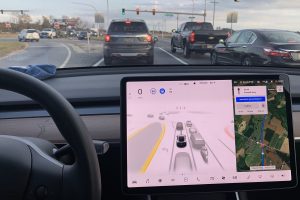Uber kicked off its Tesla rental program with Hertz roughly one year ago, and the company has published a report on its progress.
Uber’s report, published by an analyst within the company, Rainer Lempert, details the Tesla rental program’s first year in operation. The analysis primarily focuses on the program’s sustainability, how drivers reacted to the new program, and its equitability. Overall, Uber has found success, especially in their efforts to decarbonize, but the report lacks a focus on how the program has affected Uber itself.
Uber’s Hertz Tesla rental program is a relatively simple one. For roughly $334 per week (depending on location), a driver is given a Tesla Model 3 and essential maintenance and insurance. Furthermore, EV drivers are given an extra dollar per ride, up to $4,000 annually, to help recoup costs. Finally, drivers in the Hertz program receive 45% off charging at EVgo charging locations. Oh, and Uber will even pay you $40 to get to the rental site in the first place.
Mr. Lempert’s report begins with basic statistics regarding the Tesla rental program. The partnership and subsequent program started in October of 2021 and, as of August of this year, has completed over 5 million trips, 40 million miles, and been tested in 30 different U.S. markets. In turn, the program has prevented 19.9k metric tonnes of carbon emissions, or roughly 2.1 million gallons of gas, from being burned.

Mr. Lempert’s research becomes even more interesting in its details regarding the markets it has served and the drivers that have used it. Foremost, the program has served as a significant aid for Uber in achieving its EV implementation goals. 95% of drivers had never driven an EV before entering the program, and 77% now believe they will either stay with the program or purchase an electric vehicle.

The final accomplishment noted in the report was the equity achieved by the program. EVs are often seen as a vehicle of the middle and upper classes, particularly in the U.S., where the researcher notes that distribution remains heavily weighted towards higher-income car buyers. Despite this market trend, the program had a fairly even spread among different income brackets, resembling the average car market in the U.S. more broadly.

Where the report is lacking is in detail on the program’s effect on Uber. Uber has long battled profitability, only recently breaking even with quite slim margins. But with the prospect of cheaper transportation, has the company been able to increase profits? Or, at the very least, have Tesla drivers been able to attract more rides than their gas-powered counterparts?
Looking past Uber’s ever-lasting profitability question, the program is achieving positive results, at least by the metrics of sustainability, driver satisfaction, and “equitable access,” according to this report. Hopefully, this can lead to other companies, even those outside the ride-sharing business, aiding their employees in affording and using electric vehicles in their day-to-day transportation needs.





